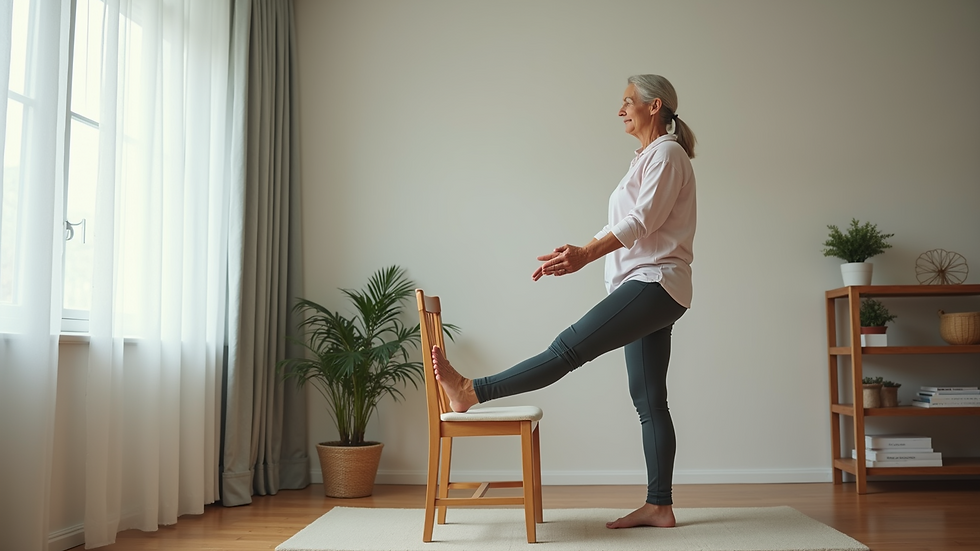Personalized Fitness Plans for Seniors: A Guide
- mtribble648
- Oct 27
- 4 min read
Maintaining physical health is essential at every stage of life. For seniors, fitness plays a critical role in preserving independence, improving quality of life, and managing chronic conditions. Personalized senior fitness plans offer tailored approaches that address individual needs, capabilities, and goals. This guide provides practical information on creating and following effective fitness routines designed specifically for older adults.
Understanding Personalized Senior Fitness Plans
Personalized senior fitness plans are exercise programs designed to meet the unique requirements of older adults. These plans consider factors such as medical history, current fitness level, mobility, and personal preferences. The goal is to enhance strength, flexibility, balance, and cardiovascular health while minimizing the risk of injury.
A well-structured plan typically includes a combination of aerobic exercises, strength training, balance activities, and flexibility routines. For example, a senior with arthritis may focus more on low-impact activities like swimming or cycling, while another individual might benefit from resistance training to improve muscle mass.
Creating a personalized plan involves assessment by a fitness professional or healthcare provider. This ensures that exercises are safe and effective. Adjustments are made over time based on progress and any changes in health status.

Benefits of Personalized Senior Fitness Plans
Personalized fitness plans offer several advantages over generic exercise routines. They provide targeted support that addresses specific health concerns and fitness goals. Some key benefits include:
Improved Mobility and Flexibility: Tailored stretching and movement exercises help maintain joint function and reduce stiffness.
Enhanced Strength and Endurance: Customized strength training supports muscle maintenance, which is crucial for daily activities.
Better Balance and Coordination: Specific balance exercises reduce the risk of falls, a common concern among seniors.
Chronic Disease Management: Exercise plans can be adapted to help manage conditions such as diabetes, hypertension, and osteoporosis.
Increased Motivation and Adherence: Personalized plans are more engaging and sustainable because they align with individual preferences and lifestyles.
For example, a senior who enjoys walking may have a plan that gradually increases walking duration and intensity, combined with strength exercises to support leg muscles.
What is the Best Fitness Program for Seniors?
The best fitness program for seniors is one that is safe, enjoyable, and effective in meeting their health goals. It should include the following components:
Aerobic Exercise: Activities like walking, swimming, or cycling improve cardiovascular health. Aim for at least 150 minutes of moderate-intensity aerobic activity per week.
Strength Training: Use resistance bands, light weights, or bodyweight exercises twice a week to maintain muscle mass and bone density.
Balance Exercises: Incorporate activities such as standing on one foot or heel-to-toe walking to prevent falls.
Flexibility Training: Stretch major muscle groups regularly to maintain range of motion and reduce stiffness.
A sample weekly program might include:
Monday: 30 minutes of brisk walking + balance exercises
Wednesday: Strength training focusing on upper body
Friday: Swimming or cycling + flexibility stretches
Sunday: Strength training focusing on lower body
It is important to start slowly and increase intensity gradually. Seniors should listen to their bodies and avoid pushing beyond comfort levels.

How to Develop a Personalized Senior Fitness Plan
Developing a personalized senior fitness plan involves several steps:
1. Health Assessment
Begin with a thorough health evaluation. This includes reviewing medical history, current medications, and any physical limitations. Consulting with a healthcare provider or fitness specialist is recommended.
2. Define Goals
Set clear, achievable goals. These may include improving mobility, increasing strength, managing weight, or enhancing overall well-being.
3. Choose Appropriate Exercises
Select exercises that align with goals and physical capabilities. Include a mix of aerobic, strength, balance, and flexibility activities.
4. Create a Schedule
Design a weekly routine that fits the individual’s lifestyle. Consistency is key, so plan sessions at convenient times.
5. Monitor Progress
Track improvements and adjust the plan as needed. Regular reassessment helps maintain motivation and ensures continued benefits.
6. Seek Professional Support
Working with a certified trainer or joining a program specializing in senior fitness can provide guidance and accountability.
For those interested in professionally designed options, custom fitness plans for seniors offer expert support tailored to individual needs.
Nutrition and Lifestyle Considerations for Seniors
Fitness plans are most effective when combined with proper nutrition and healthy lifestyle habits. Seniors should focus on:
Balanced Diet: Emphasize fruits, vegetables, whole grains, lean proteins, and healthy fats.
Hydration: Drink adequate water throughout the day.
Adequate Rest: Ensure sufficient sleep to support recovery and overall health.
Avoiding Sedentary Behavior: Incorporate light activity throughout the day, such as standing or gentle walking.
Managing Stress: Practice relaxation techniques like deep breathing or meditation.
Nutrition supports muscle repair and energy levels, which are essential for maintaining an active lifestyle.
Encouraging Consistency and Safety
Consistency is crucial for long-term success. Seniors should be encouraged to:
Start with manageable goals and gradually increase activity.
Use proper equipment and wear comfortable clothing.
Warm up before and cool down after exercise sessions.
Pay attention to body signals and avoid overexertion.
Stay connected with healthcare providers and fitness professionals.
Safety measures reduce the risk of injury and promote confidence in maintaining an active routine.
Final Thoughts on Personalized Senior Fitness Plans
Personalized senior fitness plans provide a structured and effective approach to maintaining health and independence. By addressing individual needs and preferences, these plans enhance motivation and deliver measurable benefits. Combining exercise with proper nutrition and lifestyle habits supports overall well-being.
For those seeking expert guidance, exploring custom fitness plans for seniors can be a valuable step toward achieving fitness goals. With the right support and commitment, seniors can enjoy healthier, more active lives.





Comments